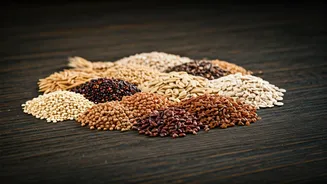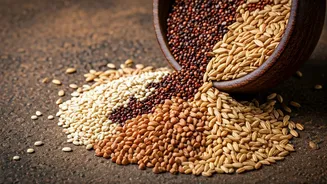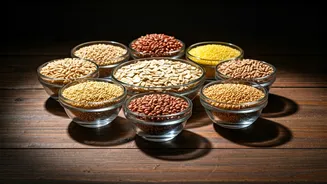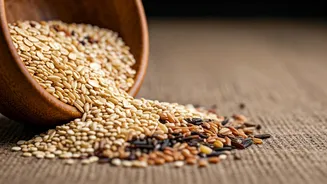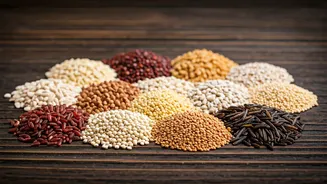Embrace Diabetes-Friendly Grains
Managing diabetes effectively often involves dietary modifications, with a focus on choosing the right grains. Understanding how different grains affect
blood sugar levels is crucial. The following list showcases ten grains that are considered beneficial for individuals with diabetes, offering options that can help control blood sugar fluctuations and improve overall health. These grains are chosen for their impact on blood glucose levels and nutritional profile, supporting both immediate health and long-term wellness.
Oats: A Heart-Healthy Choice
Oats are a well-regarded grain for those with diabetes. They provide soluble fiber, which helps slow down the absorption of sugar into the bloodstream, avoiding sudden spikes in blood sugar. Regularly consuming oats may also help in reducing cholesterol levels, benefiting heart health. Oats can be incorporated into your diet in various forms, such as oatmeal, overnight oats, or as an ingredient in baked goods. Their versatility makes them a simple and accessible option for managing diabetes effectively.
Quinoa: A Complete Protein
Quinoa is a gluten-free grain that stands out due to its high protein content, including all nine essential amino acids. This makes it an excellent choice for a well-rounded diet, especially for those who need to manage their blood sugar. Quinoa's low glycemic index helps control blood sugar levels, and its fiber content promotes healthy digestion. Whether you're making a salad or a warm side dish, quinoa adds a nutritional boost to any meal, providing a wholesome and versatile option for diabetes management.
Barley: Fiber and More
Barley is another grain rich in fiber, particularly beta-glucan, which has been shown to improve blood sugar control. Fiber helps slow down glucose absorption, preventing drastic changes in blood sugar. Barley is also associated with improvements in insulin sensitivity, making it a valuable addition to the diet of individuals with diabetes. From soups to salads, barley offers a hearty texture and flavor, adding both nutritional value and satiety to meals.
Brown Rice: A Staple Option
Brown rice is a less processed alternative to white rice, retaining its bran and germ, which are packed with nutrients. This makes brown rice a better choice for blood sugar management because it offers more fiber and a lower glycemic index compared to white rice. Incorporating brown rice into meals contributes to better blood sugar control and provides essential vitamins and minerals. It can be a simple substitution for white rice in many dishes, promoting a healthier diet.
Bulgur: Quick and Nutritious
Bulgur, a whole-grain wheat, is a fast-cooking food that also benefits those managing diabetes. It has a lower glycemic index than white rice and contains fiber, which slows down sugar absorption. Rich in vitamins and minerals, bulgur is a nutritious addition to any meal. This grain is a versatile ingredient that can be used in salads, pilafs, and as a base for various dishes, offering a balanced combination of taste and health benefits.
Millet: Ancient and Beneficial
Millet, an ancient grain, is gaining recognition for its health advantages. It has a low glycemic index and provides significant amounts of fiber and essential nutrients. This makes millet suitable for blood sugar management and general health improvement. Whether eaten as a porridge or used in a variety of recipes, millet offers a nutritious and tasty option for people with diabetes. Its versatility makes it a great alternative to more common grains, contributing to a diverse and beneficial diet.
Amaranth: Nutrient-Rich and Gluten-Free
Amaranth, a gluten-free grain, is high in fiber and protein, making it an excellent choice for individuals aiming to manage blood sugar levels. Its low glycemic index helps in avoiding blood sugar spikes. Amaranth also contains vital nutrients and minerals that support overall health. Used in various forms, from breakfast cereals to side dishes, amaranth offers a nutritious alternative, which supports both health and dietary variety.
Farro: Fiber and Flavor
Farro, a whole-grain wheat, provides fiber, which helps regulate blood sugar by slowing down glucose absorption. It also has a low glycemic index, making it suitable for managing diabetes. Farro provides a nutty flavor and chewy texture, making it an appealing and nutritious option. It can be used in salads, soups, and pilafs, adding both flavor and nutritional value to various meals.
Buckwheat: A Seed Powerhouse
Despite its name, buckwheat isn't related to wheat; it's a seed that is gluten-free. It offers fiber and has a low glycemic index, assisting with blood sugar control. Buckwheat is a good source of minerals and nutrients, making it a great food for general health. Whether you're enjoying it as pancakes, noodles, or in various other dishes, buckwheat provides both nutrition and taste, making it a good choice for people with diabetes.
